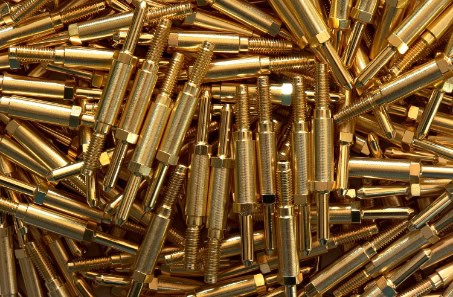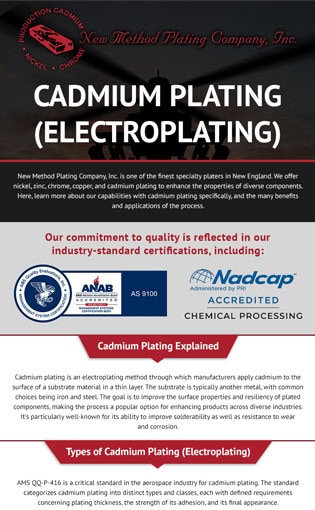Cadmium Plating (Electroplating)
New Method Plating Company, Inc. is one of the finest specialty platers in New England. We offer nickel, zinc, chrome, copper, and cadmium plating to enhance the properties of diverse components. Here, learn more about our capabilities with cadmium plating specifically, and the many benefits and applications of the process.
Cadmium Plating Explained
Cadmium plating is an electroplating method through which manufacturers apply cadmium to the surface of a substrate material in a thin layer. The substrate is typically another metal, with common choices being iron and steel. The goal is to improve the surface properties and resiliency of plated components, making the process a popular option for enhancing products across diverse industries. It’s particularly well-known for its ability to improve solderability as well as resistance to wear and corrosion.
Types of Cadmium Plating (Electroplating)
At New Method Plating, we utilize a cyanide-based electrolyte solution for our cadmium plating. While such solutions are toxic, our team is experienced in safely working with and disposing of cyanide plating baths. This electroplating technique, cyanide cadmium plating, achieves a smooth, bright surface finish on a substrate while simultaneously giving it exceptional corrosion resistance.
Cadmium plating is classified into types I through III, depending on its coloring post-treatment. Type I, or “as plated,” is cadmium plating’s natural coloring, or its appearance without undergoing any color treatments. Iridescent yellow in color, type ll is a supplementary chromate treatment. After a period of 96 hours in a 20% salt spray solution, type II cadmium plating should not expose white corrosion cadmium products, basis metal corrosion products, or pitting.
AMS QQ-P-416 is a critical standard in the aerospace industry for cadmium plating. The standard categorizes cadmium plating into distinct types and classes, each with defined requirements concerning plating thickness, the strength of its adhesion, and its final appearance. The various classes of cadmium plating and the associated thickness of coating are:
- Class 1: Minimum coating thickness of 0.0005″
- Class 2: Minimum coating thickness of 0.0003″
- Class 3: Minimum coating thickness of 0.0002″
Cadmium Plating Process
To achieve the benefits that cadmium plating offers, components must first go through a multi-step process.
Surface Preparation
- Cleaning. The electroplating process begins with a thorough cleaning of the substrate’s surface using methods such as abrasive blasting, acid pickling, or alkaline cleaning. This process step effectively eliminates surface contaminants like dirt, rust, and grease.
- Rinsing. Next, we use water to rinse the parts, washing away any remnants of the cleaning agent.
Plating Bath
- Bath Composition. We’ll make up a cadmium plating bath of cadmium oxide and sodium cyanide. These baths are typically a combination of cadmium metal ions, controlling additives, and complexing agents.
- Electroplating. We connect the substrate to a DC power supply’s cathode, the negative terminal, and immerse that substrate into the prepared plating bath. The positive terminal is adjoined with a cadmium anode. Once electrical current begins to flow, the cadmium ions reduce and the process deposits the thin cadmium coating onto the part surface.
- Plating Thickness. The current density and plating time are factors responsible for the cadmium layer’s thickness.
Post-Treatment
- Cleaning. We again rinse the plated parts with water, removing any residual plating solution.
- Chromate Conversion Coating. This post-treatment process immerses plated components into a chromate solution. An optional step, chromate conversion coating enhances both form and function, achieving a decorative surface finish on a part while improving its resistance to corrosion.
- Drying. To efficiently dry coated parts, we’ll utilize hot air or similar drying techniques.
Inspection
- Visual Inspection. Plated parts undergo a visual inspection so we can check for uneven coating thickness and pits, blisters, or other surface defects.
- Thickness Measurement. Finally, our team utilizes magnetic induction or X-ray fluorescence to measure the thickness of the plating and ensure your parts receive optimal surface protection.
Cadmium Plating (Electroplating) From New Method Plating
With nearly a century of industry experience, New Method Plating Company is a family-owned business that takes pride in providing our loyal customers with high-quality metal finishing and electroplating services. We’re committed to excellence in everything we do, maintaining compliance with all necessary industry certifications.
Our skilled team combines process expertise with advanced equipment to quickly deliver customized finishing solutions without sacrificing quality. Contact our team to learn how precision cadmium plating can enhance performance properties on your next project, or request a quote today.
© 2025 New Method Plating Company, Inc. All Rights Reserved | Site Created by Thomas Marketing Services










